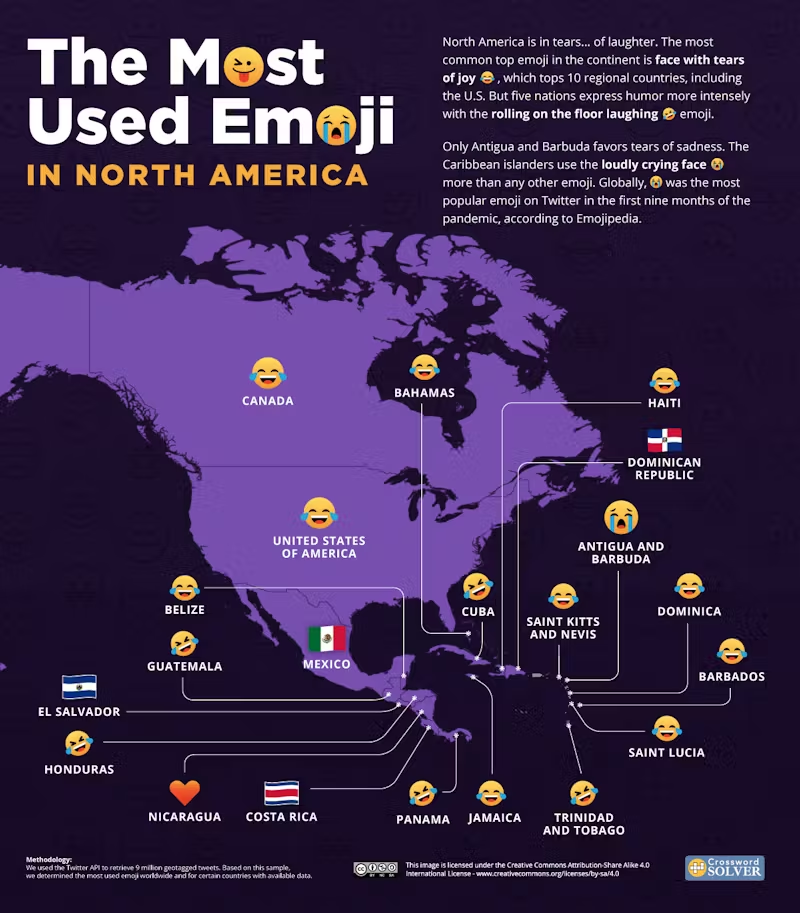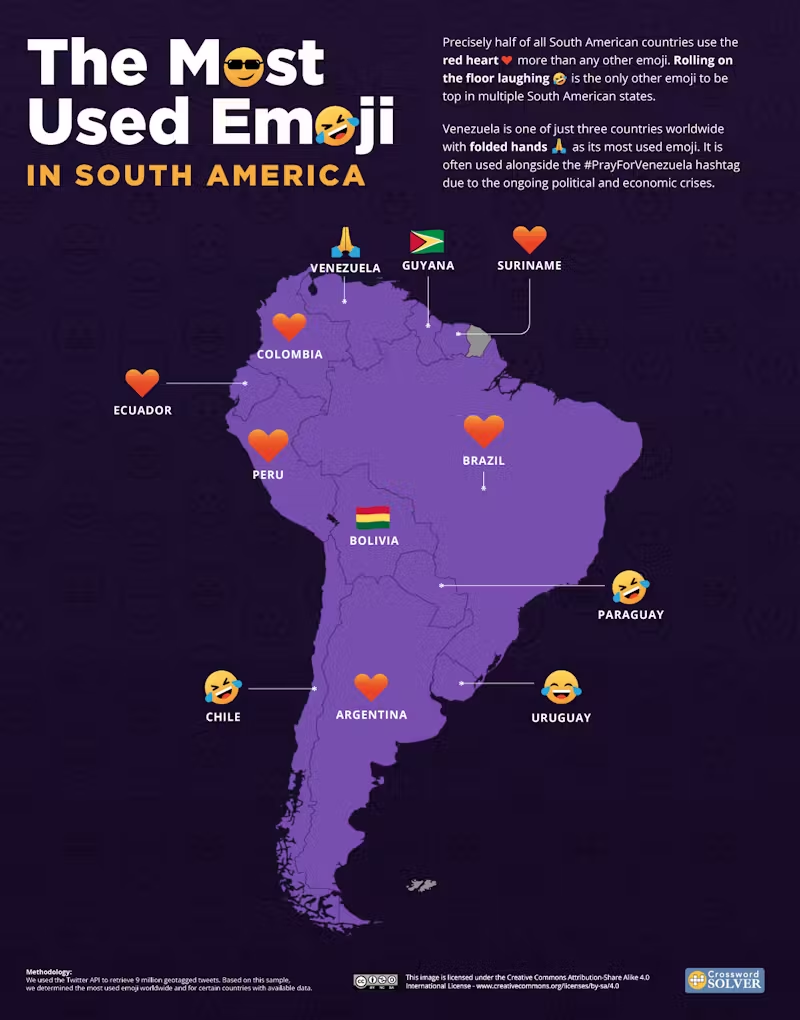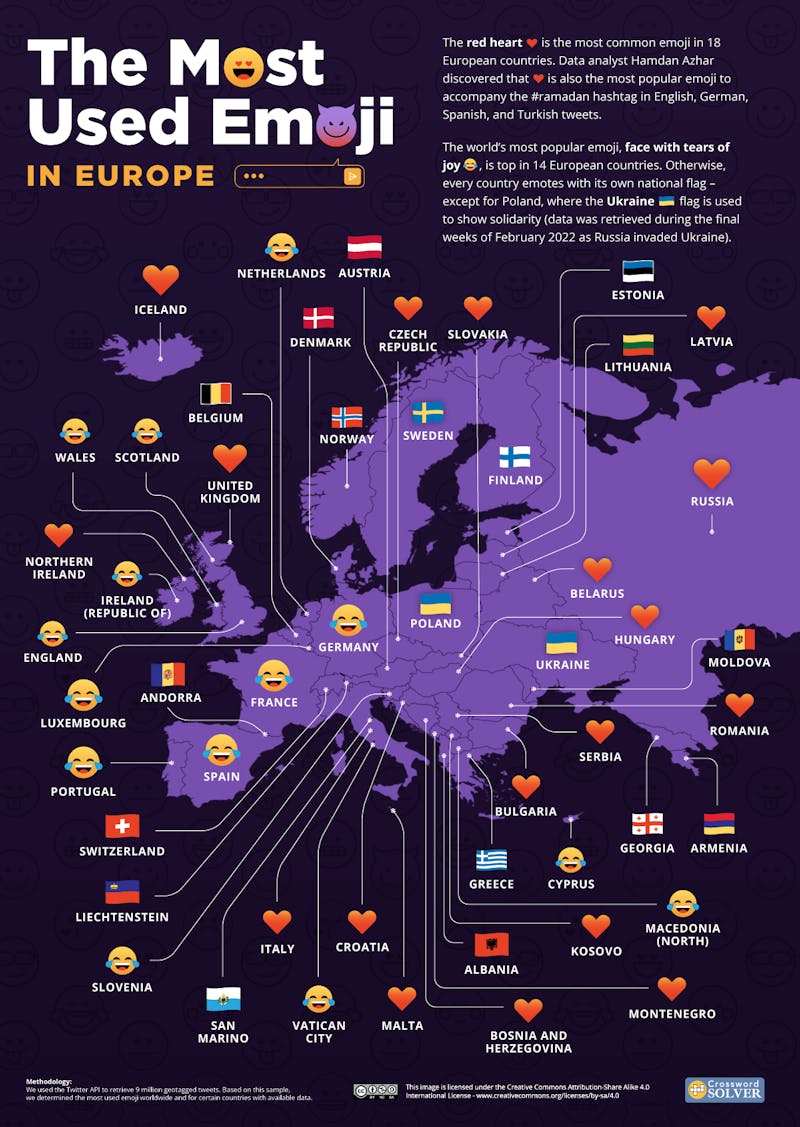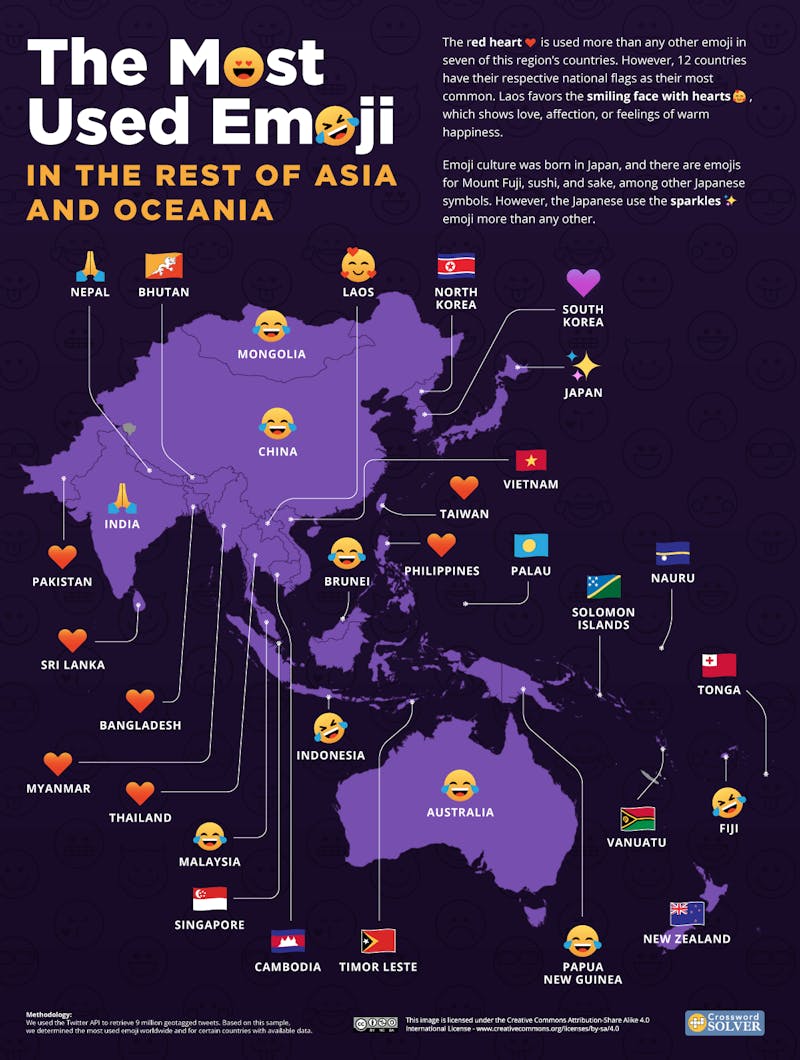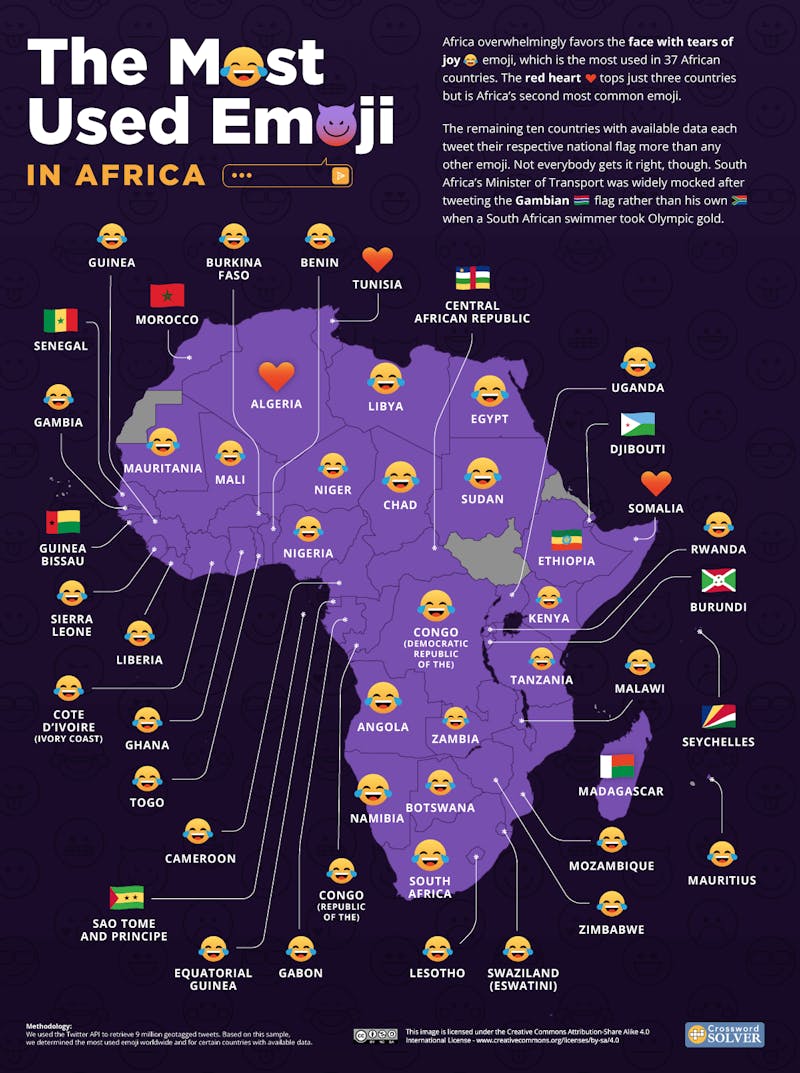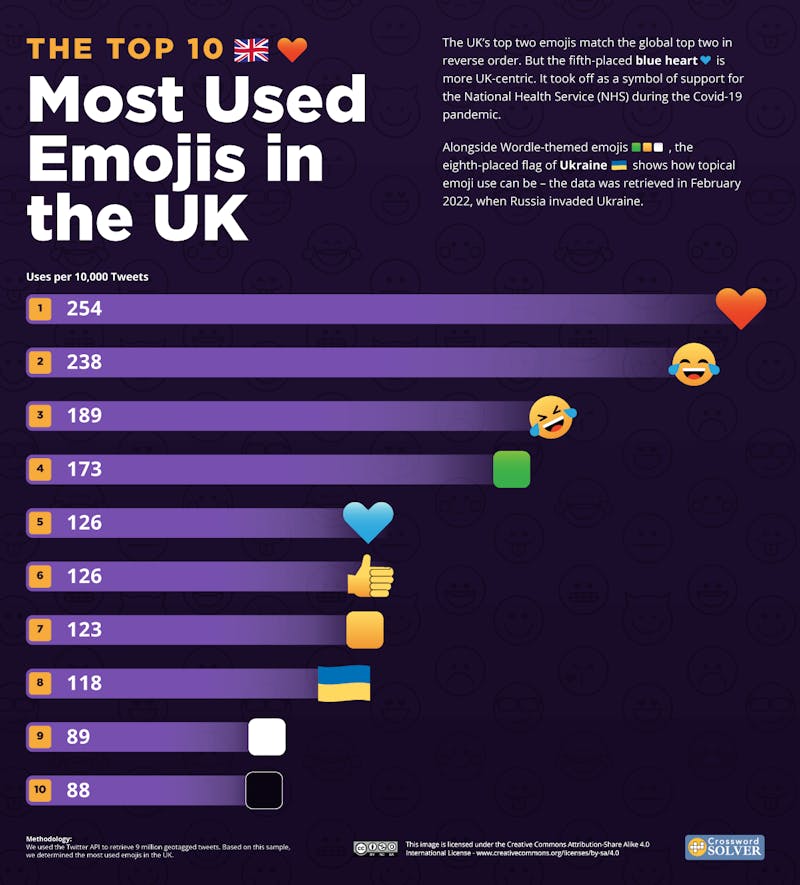The Most Used Emoji on Twitter in Every Country

Some say the emoji is a new universal language: a “pop Esperanto” for the worldwide web. But the meanings of these playful pictograms are more diverse than you might think.
Like any widespread language, ordinary users develop their own emoji vernacular and interpret the imagery through their own cultural lens. In China, for example, the clapping hands symbol is just as NSFW as the corn is on TikTok (to TikTok users, the corn emoji does not mean corn).
Meanwhile, like any language, the standardization of emojis is political. The make-up of the Unicode Consortium, which chooses new emojis, underrepresents (and further marginalizes) marginalized groups. And it over-represents the biggest tech companies, who buy expensive voting memberships on the board. Naturally, efforts to improve representation are always fraught with controversy!
Words are our business at Crossword-Solver, so we wanted to learn more about this booming form of communication that neglects to use words at all. We analyzed geotagged tweets from every country in the world to see which emojis are used the most from place to place. And we made maps of our results… because sometimes it helps to visualize what you’re trying to say.
Key Findings
- Most countries are either laughing or loving as face with tears of joy 😂 and red heart ❤️ are the first and second most used emojis worldwide.
- Face with tears of joy 😂 is the most common emoji in 75 countries.
- Wordle-themed emojis 🟩 🟨 ⬜ find their way into America’s top ten most-used emojis.
- Emojis are not a universal language. In China the clapping hands emoji 👏 suggests “making love,” while sending thumbs up👍 to a Greek may cause offence.
North America
The most common emoji in the U.S. is also the most common national number one in the world. The face with tears of joy is the go-to emoji to express uncontrolled laughter, while the tears make it suitable for use in a self-deprecating way, too. It has previously been revealed as the most-used emoji on Facebook and Instagram.
Laughter is the prevailing response across North America, with 10 countries using the tears of joy and another five one-upping them with the more extreme rolling on the floor laughing emoji. Nicaragua is the only country not to feature tears or a flag, favoring the red heart.
South America
Guyana and Bolivia lead with national pride in South America, each tweeting out their respective national flag more than any other emoji. The world favorite (face with tears of joy) claims just one South American territory, pipped by rolling on the floor laughing, which is how Chile and Paraguay feel.
The most common top emoji in South America is the red heart, which is also the second most common top national emoji worldwide. In its guide to deciphering 20+ different heart emojis, Cosmo points out that the red heart is a little basic – and not recommended for use more than once when aimed at an actual lover and not the whole of Twitter.
Europe
Europe is big on flags, with 19 out of 51 countries tweeting a national flag more than any other emoji. However, Poland is the only country not to tweet its own, instead sharing the Ukrainian flag the most during our sample period – which coincided with the start of the Russian invasion of Ukraine.
Flags aside, Europe is all red hearts (18) and faces with tears of joy (14). But the latter, despite being world number one, could soon be a victim of natural selection. “I stopped using it a while back because I saw older people using it, like my mom, my older siblings and just older people in general,” one Gen Z-er told CNN Business. Younger generations prefer the skull or coffin emoji to connote “I’m dead” (laughing).
Middle East & Central Asia
The pushpin is a deadpan emoji. It has become the centerpiece of many a meme, generally marking the stopping points on the tweeter’s journey, from good intentions to a personal fail. Kuwait is the only country in the world where the round pushpin is the most commonly used emoji. However, Kuwaitis mostly use the pushpin as a conspicuous way of tagging a location rather than to solicit eye-rolls.
In Saudi Arabia, sending a red heart can be considered a “harassment crime” in certain circumstances – leaving the offender with an SR100,000 ($26,656) fine and/or a two-year jail term. As such, the less racy white heart takes precedence as the top local emoji, making Saudi Arabia the only place in the world where the white heart is king.
Rest of Asia & Oceania
Japan has a greater selection of locally relevant emojis from which to choose than any other country. Examples include the dango candy and oni demon. Emojis first appeared on Japanese phones in the 1990s, and the emoji keyboard was first available on Japanese iPhones, so many Japanese icons were brought over to the Unicode standard.
This sparkles emoji is one such ‘Japanese original’ that made it to Unicode, and it is now the most commonly used emoji on Twitter in Japan. Its Japanese roots may not be obvious, but sparkles was inspired by its likeness in manga and anime, where it denotes ‘shiny newness’ or attractiveness. However, today sparkles are just as likely to be used ironically around a sarcastic or mocking statement.
Africa
The face with tears of joy dominates in 37 of the 50 African countries with available data. A further 10 tweet their national flags more than any other emoji.
Algeria, Somalia, and Tunisia each tweet the red heart more than other emojis. In Algeria, the red heart tends to be divided between love for the phenomenal landscape – and love for the national soccer team.
The World’s Most Popular Emojis, Visualized
If real emojis grew in size with their popularity, the world would be a terrifying place. Thankfully, the graphic below is just a data visualization demonstrating how the world’s most commonly used emojis would look if their size were related to their use. The face with tears of joy is the giant of international emoji use. It even became the only picture to be Oxford Word of the Year, with Oxford University Press calling it “the ‘word’ that best reflected the ethos, mood, and preoccupations of 2015.”
There are 3,663 official emojis, but the most popular are a lot more popular than the rest. Face with tears of joy is used nearly twice as often as third-most-popular rolling on the floor laughing, which is in turn twice as common as the folded hands emoji – which is sixth most used. However, there are efforts to make emojis more diverse. Different skin colors were first made available in 2015, while the pregnant man and pregnant person emojis are among the latest additions.
Every U.S. State’s Defining Emoji
The face with tears of joy emoji is most common across America, so we checked which emoji each state uses at a higher than average rate. The following map shows how 22 states drag up the average use of the world’s favorite emoji. Only Idaho (folded hands), Wyoming (smiling face with heart-eyes), and New Hampshire (snowflake) have a unique ‘most unique’ emoji.
Countrywide, Americans use the fire emoji 0.79% of the time – but five states use the flame at a higher average rate than any other emoji. In some usages, the fire emoji means ‘lit’ (itself slang for “very good, enjoyable, or exciting”), hot (i.e,. sexy), or high/stoned. However, the top flame states include Colorado and Arizona, which are two of the most dangerous states for wildfires.
Wordle Emojis Take Over U.S. Twitter
You’ve seen them, even if it took a while to figure out what they are. Grids of green, yellow, and white squares began appearing on Twitter at the end of 2021 as users reported their results on the word game phenomenon Wordle. By March 2022, there were 15 million such tweets – and the colored squares were all among the ten most commonly used emojis in the U.S.
Pandemic Effect on UK Emoji Usage
The UK’s top 10 emojis for February 2022 reflect the volatile nature of emoji use. At least half of them are used to reference contemporary events, including the three colored Wordle squares, the Ukrainian flag, and the blue heart – which took off as a supportive gesture for the National Health Service in the first weeks of the Covid-19 pandemic.
An International Language of Gestures
A picture may say 1,000 words, but an emoji captures a precise feeling according to an internationally recognized lexicon. More than a punctuation mark and parallel to written language, a well-chosen emoji packs a punch as a gesture – enriching written communication and lending it some of the tone and nuance that is lost from face-to-face or phone conversation.
But just as every place has its own gestures and its own take on some of them, the emoji has taken on its own life around the world. To find where each emoji is most commonly used, please check through our interactive table below.
METHODOLOGY AND SOURCES
We used the Twitter API to retrieve 9 million geotagged tweets. Based on this sample, we determined the most used emoji worldwide and for certain countries with available data.
The maximum number of tweets from the same account was limited to 1 per day to exclude bots. We used “unique appearances” to calculate the frequency of an emoji in the sample. This means that, for tweets that have the same emoji more than once, we only counted the first occurrence towards the total usage of that emoji.
For the states of the U.S., we selected the most used emoji above the national average (sum of all states).
No data was available for: Bahrain, Cape Verde, Comoros, Eritrea, Grenada, Kiribati, Maldives, Marshall Islands, Micronesia (the Federated States of), Monaco, Palestine, Saint Vincent and the Grenadines, Samoa, South Sudan, or Tuvalu.
The data was retrieved during the last two weeks of February 2022.
About the Author
Mirela Iancu is a Growth Marketer specializing in SEO, Content Strategy, and Product Marketing. A user-centered thinker, she loves numbers and data as much as words. A winning combo for SEO and word games marketing. She is also passionate about language education and the impact of tech on learning accessibility. Currently located in Barcelona, she previously founded a platform for learning Romanian online.Recent Clues
- Spot big feline protecting old feline (8) Crossword Clue
- Like some clear minerals (11) Crossword Clue
- Adds another road to a single carriageway (5) Crossword Clue
- Where Vulcan rged Crossword Clue
- Made note of Lilliputian island's far side Crossword Clue
- Do a turn, maybe, at the Round House (7) Crossword Clue
- Don't just take the right amount of fare (7) Crossword Clue
- Says, as one gives new grades to (7) Crossword Clue
- To free from obligation (6) Crossword Clue
- Event that ramps up registration Crossword Clue
- Tensided figure (7) Crossword Clue
- English film and stage actor who rose to fame playing Harry Potter (9) Crossword Clue
- Of rounded appearance (4-5) Crossword Clue
- Certain times of year when the fruit appears (5) Crossword Clue
- Male royals (7) Crossword Clue
- River on which Evesham is situated (4) Crossword Clue
- Feelings, for example, connected with love (3) Crossword Clue
- In Greek mythology, creature with head of a bull and body of a man, slain by Theseus (8) Crossword Clue
- What follows as result Crossword Clue
- Was aware that it sounded recent (4) Crossword Clue
- Anglers regularly cast out for a long time (4) Crossword Clue
- ___oholic, unable to avoid the bars (4) Crossword Clue
- Agreement to include old Poles in survey (9) Crossword Clue
- At nought degrees a toque can be put right (7) Crossword Clue
- High-profile charity (5) Crossword Clue
- Device under an upturned bottle (5) Crossword Clue
- For the hundred years of the twentieth century this New York stock exchange average increased in value on average by 7.5 percent a year (3,5) Crossword Clue
- Systematic fact-finding (8) Crossword Clue
- Alternatively take cab around beginning of December to validate retrospectively (8) Crossword Clue
- Scuba ____ Crossword Clue
- By 1936 he had already appeared in a hundred films, child star Mickey ... Crossword Clue
- Endow (anag) (5) Crossword Clue
- Francis of ___, Italian saint Crossword Clue
- An original on the hundred Australian living national treasures list, Slim Dusty's most memorable hit was A Pub ... Beer (4,2) Crossword Clue
- Spot without trouble Crossword Clue
- From_ (at a distance) Crossword Clue
- People in line overheard signal for action Crossword Clue
- South Ayrshire castle owned by the National Trust for Scotland (7) Crossword Clue
- Made criminal undercut Mafia? Not I! (12) Crossword Clue
- Illegally obtain porridge in regional travel hub (7,7) Crossword Clue
- Intrinsic quality (SEC SEEN anagram) (7) Crossword Clue
- Salmon perhaps that's potted for six Crossword Clue
- Does away with diet Caesar developed (10) Crossword Clue
- Tidal mover (4) Crossword Clue
- Cut we were unhappy about (5) Crossword Clue
- Certain chemicals Crossword Clue
- Its sticks may get pied (7) Crossword Clue
- Remains petrified, every second if boss is aimless? (7) Crossword Clue
- Quickly embraces Greek God of the skies and above (9) Crossword Clue
- Say, Iron Man and others (5) Crossword Clue
Trending Clues
- With 8-Across, post-touchdown attempt Crossword Clue
- Try to sack, as a quarterback Crossword Clue
- Remove, as a string Crossword Clue
- Moved stealthily Crossword Clue
- Fodder for a sports wonk Crossword Clue
- Lock of hair Crossword Clue
- See 7-Across Crossword Clue
- Makes on the job Crossword Clue
- There are 10 in this puzzle Crossword Clue
- Las Vegas hotel shaped like a pyramid Crossword Clue
- Move Stealthily Crossword Clue
- Pepper and O'Leary of classic rock: Abbr. Crossword Clue
- Undefined Crossword Clue
- Supporting the idea Crossword Clue
- Follower of Kafka? Crossword Clue
- Container for homemade pickles Crossword Clue
- Group trying to sack a QB Crossword Clue
- Opposite of haram Crossword Clue
- ''All the ... of Arabia will not sweeten this little hand'' (Lady Macbeth) Crossword Clue
- Support, as an idea Crossword Clue
- Reparation for injury. Crossword Clue
- Breadwinner objecting to the New Ager era (4,6) Crossword Clue
- Lock of hair Crossword Clue
- Amateur Crossword Clue
- Tempers steel by heating and cooling. Crossword Clue
- Weigh station rig Crossword Clue
- With 8-Across, post-touchdown attempt Crossword Clue
- Blue accessory for Maggie Simpson Crossword Clue
- Vegas hotel shaped like a pyramid Crossword Clue
- Sensitivity to dust, for example (7) Crossword Clue
- Journalists' credits Crossword Clue
- Awards Crossword Clue
- "Too complicated to explain," and a way to describe the end of the answer to each starred clue? Crossword Clue
- Latin American soap Crossword Clue
- Black-and-white critter Crossword Clue
- Prevent people talking about northern band (4) Crossword Clue
- Male minister Crossword Clue
- In a hurry Crossword Clue
- Moved stealthily Crossword Clue
- Long-legged water bird Crossword Clue
- Piece of cake, e.g. Crossword Clue
- Historical freeholder (6) Crossword Clue
- Moved stealthily. Crossword Clue
- Try to sack, as a quarterback Crossword Clue
- Big name in baseball cards Crossword Clue
- *Customer support line, typically Crossword Clue
- Beef option at Chipotle Crossword Clue
- Setting for Cher and Nicolas Cage's date in "Moonstruck" Crossword Clue

